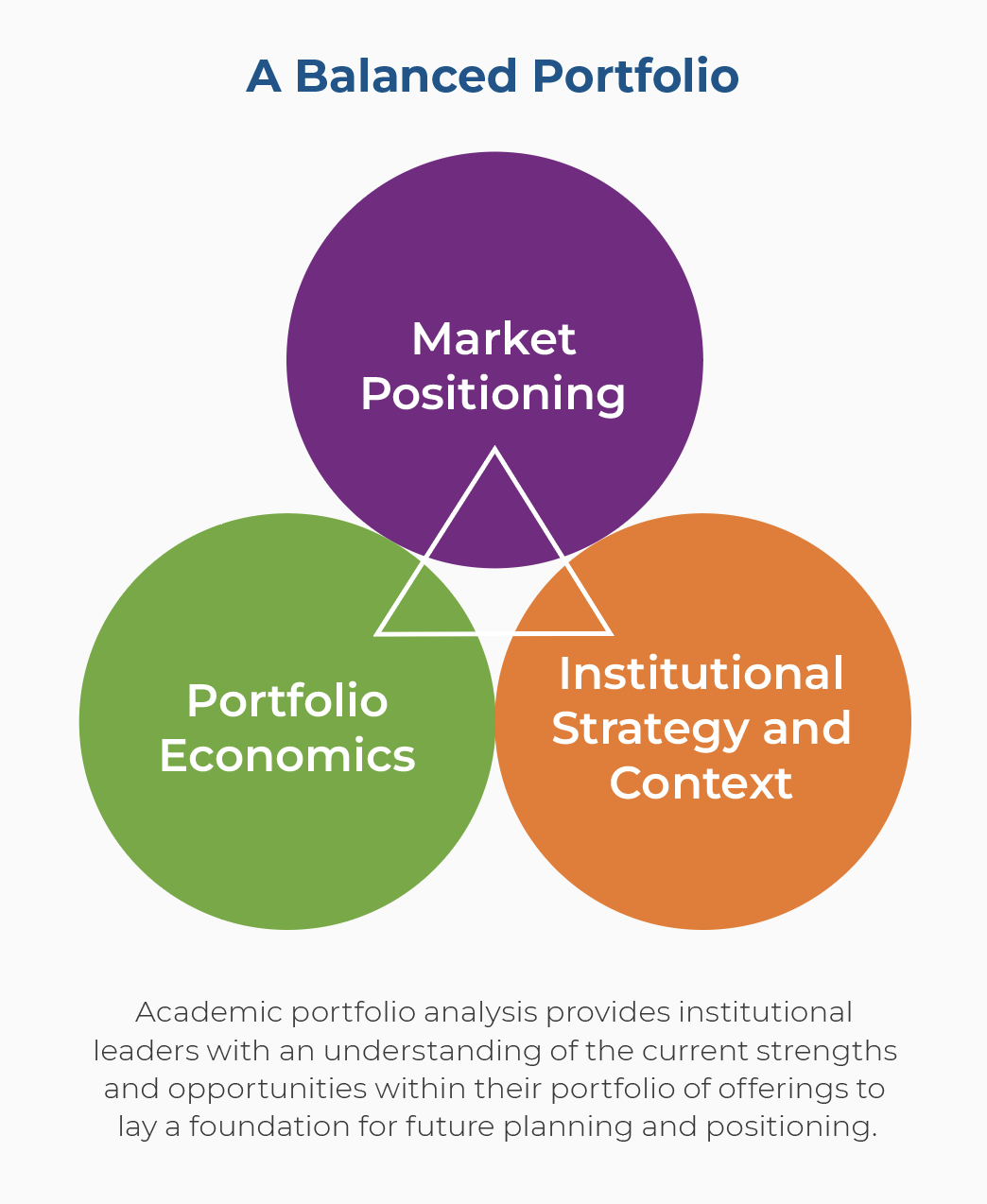In Brief
Leaders Share Their Field Experiences Building Balanced Academic Portfolios
The design and management of a college or university’s academic portfolio establish the foundations for its long-term success.
- Academic portfolio design is critical for guiding long-term planning for colleges and universities.
- It helps position the existing academic portfolio for growth and sustainability and prioritizes investments in new or evolved offerings that extend an institution’s impact in a mission-aligned way.
- Huron’s holistic methodology for academic portfolio design balances market positioning and portfolio economics with institutional strategy and context.
A Long-term Solution
Higher education institutions across the country are facing the perfect storm – evolving learner and teaching preferences, students and families questioning the value and outcomes of their degrees, increasing market competition for students as demographic shifts impact traditional markets, and growing financial concerns. To build a balanced portfolio positioned for the future, institutions need to identify new degree programs or credentials to attract new audiences and blend those new concepts with market and mission-informed adjustments to current offerings.
Together with Inside Higher Education, Huron hosted a webinar with Dr. Christine Siegel, provost at Fairfield University, and Dr. Lance Tatum, president of Northwest Missouri State University and former senior vice chancellor for Academic Affairs and chief academic officer at Troy University, to learn more about their institutions’ experiences with academic portfolio design and innovation.
Insights captured from the webinar address the importance of defining academic portfolio design for campus stakeholders and how the process can guide long-term planning in the context of an institution's mission, competitive landscape, and unique assets.
A Holistic Methodology That Integrates Multiple Inputs
Leaders are learning that academic portfolio review and design efforts must be multifaceted, accounting for market positioning, portfolio economics, and institutional strategy and context. These efforts constitute future planning exercises for the academic enterprise that incorporate and balance the institution’s mission, competitive standing in the external market, student and labor market demand trends, and internal economics to develop a clear road map to position the existing portfolio for growth and sustainability. They also help prioritize investments in new or evolved offerings that extend an institution’s impact in a mission-aligned way and, when used as an ongoing management tool, allow leaders to be responsive to trends in student success, educational preferences, curricular complexity, and faculty workload.
“Until we started to engage seriously in academic portfolio planning over the last seven years, our graduate offerings were relatively small,” noted Dr. Siegel. “Due to these efforts, we now have three professional doctoral programs and over 40 master’s degree programs and have begun to expand geographically. While we have grown, we have ensured every new program maintains alignment with our mission by designing programs that help students grow intellectually and socially and become men and women who contribute to the greater good in society.”
Similarly, Dr. Tatum shared, “We hadn’t done a full academic portfolio review before, so one of our primary goals was to develop the methodology that we could adopt and move forward with to review, analyze, and plan as we looked at ways to invest and remove barriers to improve the market position and relevance, internal economics, and student outcomes of our programs. This approach also forced us to confront long-standing issues with accessing, using, and integrating data across the enterprise to inform our work. We used the academic portfolio review as an opportunity to illustrate the benefits of how integrated data can inform and improve our decision making.”

A Customized Approach with Multiple Applications
Fairfield University leveraged academic portfolio review and design principles to identify and pursue growth to advance its mission. Troy University focused on identifying and prioritizing investments and opportunities to position and align its existing portfolio for continued sustainability in an increasingly competitive market. While these are two applications, there are other strategic questions that an academic portfolio review and design process can address.
In a poll of webinar attendees, 45% shared that enrollment growth was the most valuable outcome they hoped to achieve by conducting an academic portfolio analysis, illustrating the vital link between the academic enterprise and enrollment management. While growth was the most desirable outcome, other survey responses included:
- Aligning program market demand
- Providing academic leaders with data to inform their ongoing managerial decision making
- Identifying investment areas
- Achieving faculty workload clarity
- Optimizing the economics of the portfolio
- Improving student outcomes
For those contemplating such projects, Huron encourages you to reflect on your institution’s current position and the desired outcomes of an academic portfolio review process. In doing so, consider this sample of eight questions that our recent academic portfolio clients have used to guide their work:
- What are our academic areas of strength, and how should we define “strength” given the need to balance mission, financial sustainability, and market needs and demand?
- How can we leverage existing strengths within the academic enterprise to seize new or adjacent revenue opportunities via new programs or evolving existing program delivery/pedagogy?
- What strategies or policies could be adopted to improve portfolio economics in targeted academic areas or the portfolio as a whole?
- If structured or resourced differently, can existing programs achieve more substantial outcomes (revenue, margin, enrollment, student success)?
- Are policies or processes currently inhibiting innovation efforts or the ability to operate in greater alignment with student needs?
- What student outcomes are our academic programs delivering today? Where are there gaps between current outcomes and desired outcomes? What strategy/operational/policy changes may improve future outcomes?
- How does our portfolio of offerings compare with our closest competitors? How might we differentiate our programs in a competitive enrollment marketplace (content, pricing, and labor market alignment)?
- What types of targeted investment(s) would be most appropriate for individual programs based on their advantages and challenges both internally and within the market?
Listen to the webinar recording for deeper insights into academic portfolio design.
